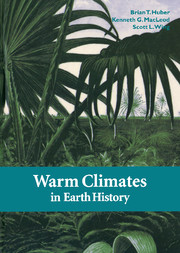Book contents
- Frontmatter
- Contents
- List of contributors
- Preface
- Part 1 Approaches to the study of paleoclimates
- Part II Case studies: latest Paleocene–early Eocene
- Part III Case studies: Mesozoic
- Part IV Case studies: Paleozoic
- 11 Permian and Triassic high latitude paleoclimates: evidence from fossil biotas
- 12 Organic carbon burial and faunal dynamics in the Appalachian Basin during the Devonian (Givetian–Famennian) greenhouse: an integrated paleoecological and biogeochemical approach
- 13 Glaciation in the early Paleozoic ‘greenhouse’: the roles of paleogeography and atmospheric CO2
- Part V Overview: climate across tectonic timescales
- Index
- Plate section
12 - Organic carbon burial and faunal dynamics in the Appalachian Basin during the Devonian (Givetian–Famennian) greenhouse: an integrated paleoecological and biogeochemical approach
from Part IV - Case studies: Paleozoic
Published online by Cambridge University Press: 06 July 2010
- Frontmatter
- Contents
- List of contributors
- Preface
- Part 1 Approaches to the study of paleoclimates
- Part II Case studies: latest Paleocene–early Eocene
- Part III Case studies: Mesozoic
- Part IV Case studies: Paleozoic
- 11 Permian and Triassic high latitude paleoclimates: evidence from fossil biotas
- 12 Organic carbon burial and faunal dynamics in the Appalachian Basin during the Devonian (Givetian–Famennian) greenhouse: an integrated paleoecological and biogeochemical approach
- 13 Glaciation in the early Paleozoic ‘greenhouse’: the roles of paleogeography and atmospheric CO2
- Part V Overview: climate across tectonic timescales
- Index
- Plate section
Summary
ABSTRACT
The Middle to Late Devonian was characterized by widespread organic carbon burial and a major biotic crisis lasting as long as 7 million years. Oceanographic and climatic mechanisms for these two phenomena have been advanced and inconclusively debated. Although both imply significant changes in marine ecosystems, there has been relatively little biogeochemical analysis of the interval, and little integration of geochemical and paleoecological data. In this study, a multi-proxy methodology for assessing changes in carbon cycling, depositional and early burial redox conditions, and nutrient dynamics through stratigraphic intervals which record changes in organic carbon burial and faunal change is developed and applied to Givetian–Frasnian strata of western New York. Analyses of core samples for amount and isotopic composition of organic materials, degree of pyritization, and organic and inorganic phosphorus content suggest that enhanced organic carbon burial was the result of efficient recycling of the limiting nutrient element, P, within the shallow marine ecosystem of the Appalachian Basin. This interpretation does not support water column stratification, but does provide a mechanism to explain changes in brachiopod and goniatite diversity which occur across the study interval. Ultimately this methodology will provide a means of investigating biogeochemical dynamics in the context of both short-term, regional events and long-term global phenomena.
- Type
- Chapter
- Information
- Warm Climates in Earth History , pp. 351 - 385Publisher: Cambridge University PressPrint publication year: 1999



